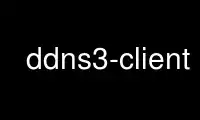
This is the command ddns3-client that can be run in the OnWorks free hosting provider using one of our multiple free online workstations such as Ubuntu Online, Fedora Online, Windows online emulator or MAC OS online emulator
PROGRAM:
NAME
ddns3 - ddns.nu remote update client
SYNOPSIS
ddns3 --user user --pass password [ options ] command ...
DESCRIPTION
ddns3 updates IP-Handles on the ddns.nu remote update server. This allows remote
automated updates rather than using the website via a browser.
OPTIONS
--user user
Specifies the username to authenticate with.
--pass password
Specifies the password to authenticate with.
--host hostname
Override the default server hostname to connect to. The default server hostname is
ns.ddns.nu.
--port portnumber
Override the default TCP port to connect to. The default TCP port for the ddns3
protocol is 2164
--auth authtype
Specify what type of authentication protocol to use. The available types are:
plaintext, crypt, md5, ddns, and strong. The default type is ddns which is secure
in the sense that the username is sent in cleartext, but the password is sent
hashed in such a manner as to defeat replay attacks by utilising a salt sent from
the server.
COMMANDS
list List all IP-Handles and their current values for the account. You may do this
multiple times, for example it is perfectly legal (and perhaps even useful) to do a
list, followed by a set, and then another list to observe the change.
set handle-name ip-value
Set an IP-Handle named handle-name to the IP value ip-value. Similar to list you
can specify as many such operations on the command line as you wish and they will
be executed in the order specified.
guess handle-name ip-source
Set the IP-Handle named handle-name to the IP value derived from IP seen by the ip-
source end of the update connection. The ip-source is specified as either remote
or local. Again you may specify multiple guess commands on the command line and
they will be executed in order.
Using the local option saves you from having to specify the IP on the command line.
Local guessing usually gets the IP correct as it takes the local address of the
socket making the update connection. With conventional routing arrangements this
is likely to be the IP you want.
However the remote option sets the IP-Handle to the IP that the server sees the
connection as originating from. This is most useful if you are running the client
from behind a NAT gateway which itself is incapable of running the client. In this
case the IP of the NAT gateway is used, rather than the probably martian IP of the
host the client is actually executing on.
DIAGNOSTICS
Useful error messages are produced on stderr, all other runtime output goes to stdout.
On runtime exception the return value of the process may be useful in scripting:
-1
The usage message was generated by running the command with no arguments.
-2
The argument parser didn't like the command line.
-3
A connection could not be established with the update server.
-4
Authentication failed.
-5
Network errors closing the connection (these can often be ignored).
-6
Some kind of internal logic error in the process, like a malloc/free failure.
The process returns a positive count of the number of commands executed on the server that
generated an error, or zero on error free completion of all commands.
Use ddns3-client online using onworks.net services
